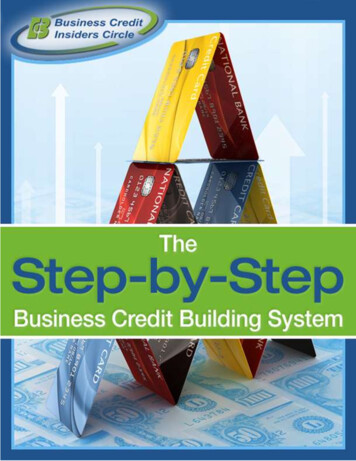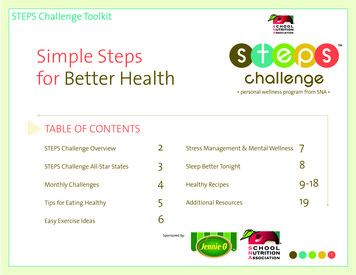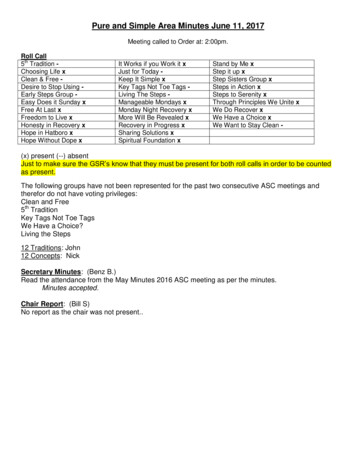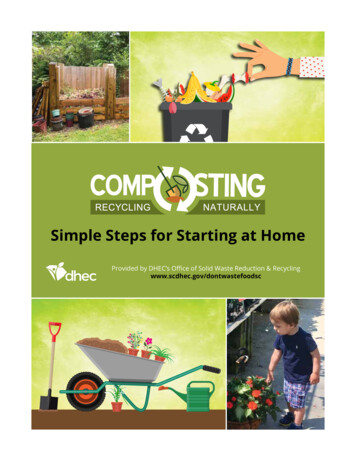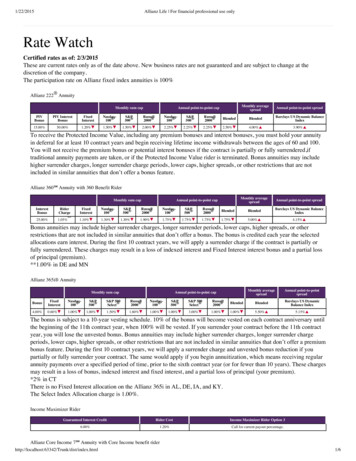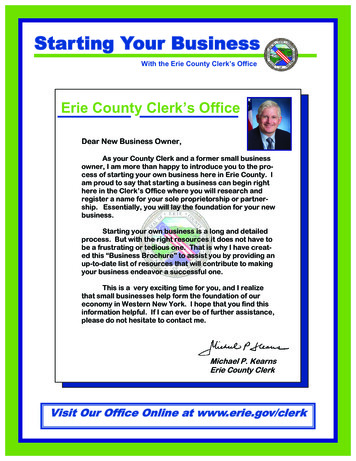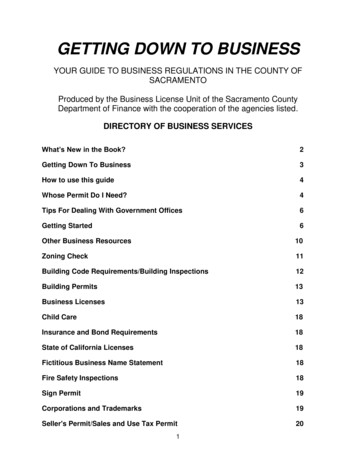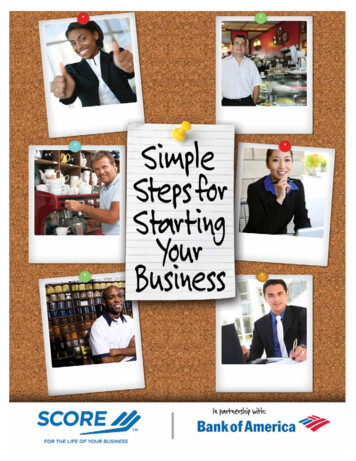
Transcription
WelcomeDear Entrepreneur,Dear Entrepreneur,As mentors for America’s small businesses, SCORE, in partnership withBank of America, is proud to bring you this practical workbook to help youpursue your business dreams, ideas and goals and put them into action.We are pleased to partner with SCORE tobring you a useful and informative guide tostarting your own business. At Bank ofAmerica we understand the vital role smallbusinesses have in the U.S. economy and inour communities. Our hope is that the information provided in this booklet will be aresource you will use often as you developyour idea into a successful small business.SCORE and Bank of America are dedicated to helping entrepreneurssucceed. As part of that common goal, we offer this educational resource tohelp you plan for that success. This workbook serves as a primer, offeringpractical information and exercises that will help you know whether startinga small business is right for you.But you don’t have to go it alone. SCORE provides other great resources likementoring and workshops, including the Simple Steps for Starting YourBusiness workshop series on which this workbook is based. Attending thisworkshop, which includes one-on-one mentoring with a SCORE expert, willprovide you with a solid foundation for pursuing your business idea. It’s allabout helping you live your dream.Every day, SCORE’s 13,000 mentors volunteer their time and expertiseto help small business owners like you with confidential, free businessmentoring. Founded in1964, the SCORE Association has helped morethan 9 million entrepreneurs start, build, expand and protect theirsmall businesses.Use this workbook as the first step to making your startup dreams cometrue. Then, take the next step and contact your local SCORE office to bematched with a SCORE mentor who can help you every step of the way. Youcan find the SCORE office nearest you by going to www.score.org/chapters.Bank of America shares SCORE’s goal tofoster the success of small businesses andsupports SCORE’s mission to provide valuable information and guidance to new entrepreneurs and established businessowners. Through our relationship withnearly 4 million small businesses, we workwith our customers every day to offer guidance and the financial tools to help smallbusiness owners achieve their goals.I applaud your entrepreneurial spirit andwish you success in starting your business.We wish you prosperity and success.Regards,W. Kenneth Yancey, Jr.Chief Executive OfficerSCORE AssociationI simple steps for starting your businessRobert HilsonBank of AmericaSmall Business ExecutiveBank of America makes no express or implied warranties withrespect to any aspect of this booklet, nor does it guaranty anysuccess or promise any results, and hereby disclaims the same tothe extent allowed by law. You are not bound by anyrecommendations provided herein and retain full responsibilityfor the results achieved by your business. Bank of America is aregistered trademark of Bank of America Corporation.
Table of Contents23-14IIINTRODUCTIONISECTION 1: READY TO START? I3 myths and realities of entrepreneurshipThe truth about business ownership4 do you have what it takes?Assessing your skills and experience5 know your options: different types of businessesA closer look at various ways of starting a business8 components of business ownershipUnderstanding the many roles you’ll play as a business owner9 making it legalThe nuts and bolts of launching a new business12 business plan basicsWhy you need a business plan15-30ISECTION 2: GREAT IDEA! I15 getting your business ideaSteps to develop and fine-tune your business concept20 doing market researchSteps to identify your target audience and learn how they buy23 doing competitive researchHow to know what your competitors are up to27 pricing your product or serviceLearning to properly price your product or service for business success31-39ISECTION 3: MARKETING YOUR BUSINESS31 branding your businessISteps to creating your brand35 developing your marketing planCrafting a plan to communicate your marketing message38 marketing your business with social mediaWhat you need to know to use social media effectively40-57ISECTION 4: FINANCIAL MATTERS I40 financial planning: why you need itHow to forecast your sales, costs, profits and assets45 understanding and using financial statementsThree primary financial statements you need to know about53 finding financing for your businessHow and where to start your search for capital59-60ISECTION 5: THE GO OR NO-GO DECISION59 go or no-go?IMaking the big decision about your business ideaCopyright 2011 The SCORE Foundationsimple steps for starting your business I1
IntroductionDREAM BIG!Do you dream about startinga business? You’re notalone—millions ofAmericans share that dream.And yet, not everyone hasthe courage to get started.But if you’re reading this,you have already taken thefirst steps toward turningyour dream into reality.Too many criticize dreamers like you proclaiming,“Dreamers only dream, doers do.” But that’swrong. You can’t become a doer without firsthaving been a dreamer.Dreams are the stuff entrepreneurs are made of.Think about Steve Jobs, Bill Gates, Richard Branson,Oprah Winfrey, Sam Walton, Walt Disney, MaryKay Ash. What do they have in common? They allstarted with nothing but a dream, and builtmultimillion-dollar businesses.Obviously, dreaming alone isn’t enough. You have todo your homework, create a plan and take action.You will have good days and bad ones. But don’t getdiscouraged. As Walt Disney said, “If you can dreamit, you can do it. Always remember this whole thingwas started by a dream and a mouse.”Simple Steps for Starting Your Business is more thanjust a guide to business ownership. It’s really ablueprint for helping make your dreams come true.SCOREMentors2I simple steps for starting your businessEDITORIAL TEAMIvice president of education: K. Jai Hokimidirector, marketing and Communications: Bridget Weston Pollackproject managers: Candice Stennett & Heather HendyVOLUNTEER CONTRIBUTORS:austin SCORE James Binnabose, Richard Jozwiakowski, Carleton Smithbaton rouge area SCORE Harold Allison Sr.bergen county SCORE Peter Loder, John Sanchezchester county SCORE James Schoonovercolorado springs SCORE Ric Denton, Jerry Musselman, Gerald Smithdayton SCORE Arnold Sandnessfairfield county SCORE Michael Allocca, Lesley Apt, Elliot Baritz, PrestonCarnes, Jr., Patricia Duncan, Thomas Greenbaum, Ruth Kelley, FranceLaFlamme, Patricia Muncy, Jonathan Naiman, Becca Nell, E. MichaelO’Malley, Rebecca Ryan, Norman Sylvester, Diane Winstonft. lauderdale SCORE Carlos Ayala, Tapan Chakrabarty, Arthur Donovan,Michael Greenberg, Jack Hardy, Edward Joffee, Tom Petersen, KendrickPierre, Eric Thompson, Neil Tortorellagreater bridgeport SCORE Michael Conwaygreater cincinnati SCORE Richard Johnston, Thomas Moongreater phoenix SCORE Mary Ann Weiss, Andrew Beran, Neil Feolahouston SCORE Donald Doggett, George Holland, William Krause, OliverMann, Raj Mashruwala, Bob Meisel, Irwin Miller, Al Reed, Dolores Zamoralancaster SCORE Louis Davenport, Gerard Glennlouisville SCORE Joseph Hatfieldmanasota SCORE Douglas Barber, Gregory Hoffmann, Tom Latimer, JosephPfeiffer, Jeanette Watling Millsminneapolis SCORE Bruce Becker, Mort Harris, Edward Hennen, Loren Herbst,Marshall Jones, Randi Luoto, Thomas Schaefer, Daniel Shidla, William Wisemonmouth SCORE R. Michael Sullivan, Robert Sullivannorthern nevada SCORE Judy Haarprinceton SCORE Marc Binder, William S. Litchman, Leon Petelle, Saleem Sufisan antonio SCORE Carter Crewssan diego SCORE Jack Philbinsanta cruz county SCORE David HarkenSCORE naples George Ahearn, Robert Anderson, Joseph Binder, BeckyBokrand, Frank Friend, Jeri Glueck, Chick Heithaus, Vincent Izzi, CarolMarlow, James Underwood, Karl WilliamsSCORE santa fe & northern new mexico Nancy Geddes, William Moffett,Richard Strangersouthern arizona SCORE Charles Higginsst. paul SCORE Gregory Boettnertreasure valley SCORE C. Norman Beckert, Jeffrey Weekswilliamsburg SCORE Alan Wonsowskidesign & layout Mark Kozakeditorial services GrowBiz Mediainquiries: education@score.orgAll images are used under license from ing.mhtml
section 1: Ready to Start?Myths and Realities of EntrepreneurshipDo you really know what it means to be an entrepreneur?Here are some common myths about business ownership.myth: As an entrepreneur, you won’t have towork so hard or put in such long hours.reality: On average, entrepreneurs work far longerhours than employees do—but you’ll likely enjoy itmore because you’re building something of your own.reality: Entrepreneurs do get to subtractbusiness expenses from their gross income—but they still have to pay taxes on theirnet income.myth: As a business owner, you won’thave a boss.reality: You don’t have a boss—you havemany: Your clients and customers.myth: My product/service is unique and there isno competition.reality: There is always competition. It may be in adifferent form or delivered in a different manner,but it exists and you need to recognize and dealwith it.myth: Business owners get to do what theywant to do.reality: Sure, you’ll do some of what youenjoy—but some of your time will be spent ontasks you find difficult or boring.myth: Business owners can deduct everything,so you won’t have to pay taxes.A good idea is agreat start, but ittakes hard work,research, planningand successfulimplementationstrategies to turnyour idea into abusiness.reality: business success%33%67%67%33%67%IOne big myth isthat the majority ofstartup businessesfail. In fact,according to datafrom the SBA,67 percent of newbusinesses aresuccessful afterfour years; only33 percent fail.FAILEDSUCCESSFULsimple steps for starting your business I3
Do You Have What It Takes?section 1: Ready to Start?Lots of people have good business ideas—but not all of them have thecharacteristics needed to make their businesses succeed. Successfulentrepreneurs have the qualities listed below in common. Some of thesefactors are inborn traits, others can be learned, and still others areexternal and harder to control. The more of these factors you have onyour side, the greater your chances of success.! Entrepreneurial qualities! Education or work experience in yourchosen industry! Strong work ethic! Effective time management skills! Ability to multitask! Management skills! Willing to ask for help and advicefrom othersLots of peoplehave goodbusiness ideas—but not all ofthem have thecharacteristicsneeded to maketheir businessessucceed.4! Self-motivated! Resourceful! Responsible! Organized! Persistent! Decisive! Good health! A supportive familyI simple steps for starting your businessDO YOU HAVE THE FINANCIAL RESOURCES?Personal traits aren’t the only factor in business success. Starting a business costs money. To assess howrealistic startup is for you, begin by consideringyour personal budget. Add up:! Your total monthly cost of living! Areas where you can cut back! Outstanding debt! Amount in savings! Amount needed to cover 6 to 18 months ofexpenses (the average time before a newbusiness makes a profit).Also add up your startup costs, including:! Tools or equipment! Leasehold improvements! Licenses and permits! Professional fees! Initial inventory! Working capital reserve fundInadequate capital is a key reason businesses fail. We’ll discuss how to estimateyour startup costs and ways to obtain thecapital you need in more detail in Section 4.
section 1: Ready to Start?Know Your Options: Different Types of BusinessesStarting a new business fromscratch is what most peoplethink of when they considerbecoming entrepreneurs.But this isn’t the only way toget into business foryourself. Here’s a closer lookat various ways of starting abusiness.1 I starting a new businessIadvantages! You’re not hampered by the previous image orequipment of an existing business.! You can choose your own location, name and logo, andbuild your own business relationships.! You can explore new markets and directions.2disadvantages! You have no existing customer base to build on.! You’re taking a bigger risk than if you were buying anexisting business.! Because your business has no track record, it will beharder to find financing.I buying an existing business Iadvantages! You gain an established customer base, location andsupplier relationships.! The business is a known entity with a proven formulaand name recognition.! You can review the business’s records before buying tomake sure it’s profitable.! Since the business has a track record, it may be easier toobtain financing.disadvantages! Hidden problems with the business could come back tohaunt you—such as debts, liens or misrepresentationsabout profitability.! The business has a reputation, but is it always agood one?! The business’s inventory could be obsolete; its assetsand/or goodwill could be inflated.! Employees may be loyal to the former owner, causingmanagement issues.! There’s no guarantee the business’s success willcontinue under your ownership.simple steps for starting your business I5
Know Your Options: Different Types of Businesses3section 1: Ready to Start?I buying a franchise Iadvantagesdisadvantages! As a franchisee you become part of a system with awell-known image and proven products or services.! You don’t have as much freedom as an independentbusiness owner.! You have the marketing and sales power of thefranchisor behind you.! You must pay ongoing royalties and other fees.! You get training and guidance from the franchisor.! You must sign a binding contract that limits yourability to exit the business.! You’re part of a network and can turn to otherfranchisees for help.! The franchisor’s problems—whether financial, image orotherwise—are your problems, too.4I home-based business Iadvantages! Working from home is convenient.! You save money on commuting, dry cleaning, lunchesout and other daily expenses.disadvantages! Zoning or deed restrictions may prohibit home-basedbusinesses.! Working from home can be isolating and lonely.! You have a flexible schedule and can work whenyou want.! As a home-based business, you will have moredifficulty finding financing.! You could gain tax advantages since you could deductthe portion of your home used for business.! Distractions from family or neighbors may make ithard to work.! Home-based businesses are often subjectto IRS scrutiny.6I simple steps for starting your business
section 1: Ready to Start?5Know Your Options: Different Types of BusinessesI nonprofit organization Iadvantages! A nonprofit may qualify for government or foundationgrants.! Nonprofit status offers protection from liability fordirectors and employees of the business.! You can pay salaries to employees and consulting feesto contractors.6disadvantages! A nonprofit must focus on educational or charitablepurposes and cannot profit those who created theorganization.! All profits remain within the organization.! You must apply and qualify for 501c3 status or sales taxexemption.I online business Iadvantagesdisadvantages! Startup costs are lower than with a brick-and-mortarbusiness.! Low conversion rates—on average, only 2 percent ofvisitors to an e-commerce site make purchases.! You can do business with customers all over thecountry—or world.! Low barriers to entry for an online business mean thereis more competition.! Customers appreciate the convenience of accessingyour business 24/7.! Visitors have high expectations for online businessesand less tolerance for problems.! You have the flexibility to do business from anywhere,anytime.! Being unable to touch merchandise can makecustomers less likely to buy.simple steps for starting your business I7
Components of Business Ownershipsection 1: Ready to Start?If you are currently an employee, you’re probably responsible for one areaof business—say, sales or accounting. As an entrepreneur, however, you’llwear many hats and be responsible for making sure all the componentsof your business run smoothly.NOT ONLY ARE YOU THE CEO OR PRESIDENT, BUT YOU’LL ALSO BE IN CHARGE OF:administration – answering phones, handling paperwork, office management and insurance issuesaccounting – bookkeeping, taxes, payables and receivableshuman resources – hiring, firing and managing employeesmarketing – creating and promoting your company’s imagevia advertising, PR and moresales – prospecting for new leads, cold calling, makingsales presentations and closingEven if you wereskilled in all theseroles, you wouldn’thave time tohandle all ofthem. Which aremost important toyour business?Which will youfocus on andwhich will youdelegate? In whatorder of priority?customer service – taking orders, handlingcomplaints, building relationshipsproduction and fulfillment – manufacturing yourproduct or arranging to have it made; shipping andwarehousinginformation technology – choosing, purchasingand troubleshooting technologyphysical plant – selecting your location,negotiating leases, maintaining siteTHINK ABOUT THE AREAS ABOVEAND CONSIDER:! Do you have weaknesses in any of these areas?! Can you take a course to improve your skills in theareas where you’re weak?! If there are duties that don’t fit your skills, canyou hire employees, take on a partner oroutsource these tasks?! Even if you were skilled in all these roles, you wouldn’t have time tohandle all of them. Which are most important to your business? Which will youfocus on and which will you delegate? In what order of priority?8I simple steps for starting your business
section 1: Ready to Start?Making It LegalWhen it comes to the nuts and bolts of launching your new business,there are three primary considerations:# Choosing a legal business structure Understanding government rules and regulations affecting your business% Buying business insuranceCHOOSING A LEGAL BUSINESS STRUCTUREYou have several options for the legal structure ofyour business. A written agreement reviewed by anattorney is essential. Here’s an overview:" sole proprietorship: In this formof doing business, one person (you)owns and operates the business. On theplus side, your business earnings aretaxed just once, and you alone are incharge of all business decisions. On thedownside, sole proprietors are personallyliable for any claims against theirbusinesses, and often have more troublegetting financing. Many businesses startout as sole proprietorships, then switch tomore complex structures." partnership: In a general partnership,both partners manage the business and areresponsible for its debts. In a limitedpartnership, certain (limited) partners areinvestors but do not manage the business.One advantage of partnerships: Thepartnership doesn’t pay tax; partners reportprofits or losses on their personal tax returns.The disadvantage: Partners are personally liablefor any debts of the business.Learn more aboutgovernmentregulations at thesewebsites:Department ORG" “C” corporation (conventional):Incorporating protects you from liability forthe company’s debts or claims against it. Acorporation can sell stock, enabling you toraise money. However, corporations arestrictly regulated and are taxed twice—thecorporation pays income tax, andshareholders pay taxes on any dividends.simple steps for starting your business I9
Making It Legal" “S” corporation (subchapter):An S corporation protects ownersagainst liability and provides more taxbenefits than a corporation. Thecorporation doesn’t pay federal incometaxes; profits and losses are reported onshareholders’ individual tax returns. Butcomplying with regulations can be costlyand time-consuming, and you’re limited toa set amount of shareholders, which maybe restrictive if you’re seeking to raise lotsof capital." limited liability company (LLC): AnLLC offers liability protection like acorporation, but without double taxationbecause earnings and losses are reported onthe owners’ personal taxes. There is no limiton the number of members. Owners ormembers in a multiple-member LLC shouldhave a written membership agreement reviewed byan attorney.Always discuss your legal options with yourattorney and accountant before making a decision.SCORE mentors are also available to help youunderstand your options.GOVERNMENT REGULATIONSAND YOUR BUSINESSTo keep your new business on the right side ofthe law, understand the government regulationsyou must comply with.business registration, licenses andzoning approval: All businesses need to beregistered either in the state where they will bedoing business (LLCs and corporations) ortheir county of residence (sole proprietors).Wherever registered, the company needs aphysical address (not a P.O. Box). Registrationfees are usually under 200; there are alsoannual fees, which vary. Companies can beregistered in one state as a “domestic” companyand in other states as a “foreign” company.Depending upon the nature of the business,some companies also need to obtain state,county and/or municipal licenses. Contact yourcity and county for more information, anddiscuss your legal options with your attorney.10I simple steps for starting your businesssection 1: Ready to Start?As a startupentrepreneur, you’llneed these keyplayers on your team : BANKER LAWYER ACCOUNTANT INSURANCE AGENT BUSINESS MENTORFind them by askingfriends, relatives andcolleagues forrecommendations—then checking outreferences.Find a mentor atSCORE (www.score.org)!
section 1: Ready to Start?Making It Legallabor and immigration laws: If you hire employees, youneed to comply with state and federal labor laws regulatingwork hours, breaks, safety and many other factors. There arealso laws governing the hiring of immigrants.IRS and social security withholding and payments:Even if the only person you pay is yourself, you areconsidered an “employer.” You must follow InternalRevenue Service (IRS), state and local guidelines formandatory withholdings (taxes, Social Security, etc.), andeither use a payroll service or set up bank accounts todeposit those funds.INSURING YOUR BUSINESSIt may not be the first thing you think about whenstarting a business, but if you don’t purchase properinsurance, all your hard work could disappear in theblink of an eye. Consult an insurance broker todetermine what types of insurance you need. Thesemay include:property: Covers fire and other loss to buildings,building contents, inventory and home-basedbusinesses. Add-ons such as business interruptioninsurance can expand this coverage.liability: Covers bodily injury and propertydamage to others caused by accidents on yourproperty, such as if a customer slips and falls at yourplace of business.It may not be thefirst thing you thinkabout when startinga business, but if youdon’t purchaseproper insurance, allyour hard workcould disappear inthe blink of an eye.motor vehicle: Covers bodily injury and propertydamage resulting from the business use of yourmotor vehicles, such as if an employee drives acompany van to make deliveries.umbrella liability: Provides additional liability insuranceabove the limits in your basic automobile and generalliability policies.worker’s compensation: Covers injuries, death and loss ofwages to workers injured on the job, including the owner, andprotects you against employee lawsuits for damages.health: If you rely on your current job to receive healthinsurance, you’ll need to look into private health insuranceoptions before starting your business.life: Many business partners buy “key man” lifeinsurance on the partners in the business. If one ownerdies, the proceeds enable the surviving partners to buyhis or her share from the heirs.simple steps for starting your business I11
Business Plan Basicssection 1: Ready to Start?Why do you need a business plan? Some entrepreneurs think a businessplan is only used to get financing. In reality, there are many more usesfor a business plan. A well-written business plan:" Gives you an objective view of yourbusiness idea so you can enhance itsstrengths and shore up its weaknesses" Communicates your ideas to the rest ofthe team" Becomes the foundation for futureplanning as your business growsWHAT’S IN A BUSINESS PLAN?THE BASICS ARE SIMPLE:" Table of Contents" Executive Summary" Section One: The Business" Section Two: Financial Forecasts" Section Three: Supporting DataLet’s take a closer lookat each section of abusiness plan.EXECUTIVE SUMMARY:The executive summary is an overview of thebusiness plan. It briefly explains the company’s inception, the business idea, the management experience of the executive team andhow the company plans to achieve success. Itcontains:" A brief description of the business" Whether you will seek a loan or investors" How much money you need" How the money will be used" When loans will be repaid" Revenue model and return on investment12I simple steps for starting your businessThe executivesummary is anoverview of thebusiness plan. Itbriefly explains thecompany’s inception,the business idea,the managementexperience of theexecutive team andhow the companyplans to achievesuccess.
section 1: Ready to Start?Business Plan BasicsAlthough the executive summary is the first partof the business plan—and, often, the only partpotential investors read—you should write it last,after you have thought through all the otherelements of your plan.SECTION ONE: THE BUSINESSThis part of your plan explains what your businessdoes and how it will operate. Include:" A description of the business" A description of the product or service" An assessment of the market need forwhat you’re selling" Your location and why you selected it" An assessment of the competition andhow you will beat them" A description of key management andpersonnel, their experience and backgrounds" How you will use new funds (if you’reseeking financing)SECTION TWO: FINANCIAL FORECASTSThis section is a detailed plan of where the moneyto start your business will come from, how it willbe spent and projected growth. It includes:" A capital equipment list" Projected income and expensesSECTION THREE: SUPPORTING DATAIn this section, you show that you’ve doneyour due diligence by providing backupfor the information you providedelsewhere. Prove what the facts are andwhere you got your data.Although theexecutive summaryis the first part ofthe business plan—and, often, the onlypart potentialinvestors read—youshould write it last,after you havethought through allthe other elementsof your plan." Assets, liabilities and equity" Sources and uses of funds (cash flow)" A break-even calculationWrite a vision statement for your business. It should contain:# the overall purpose of your business: What are you trying to achieve? Why are you in business? what your business does: Describe the products and services it provides.% what’s important to your business: What are the values your business lives by?Start now to think about your business plan. Turn the page to create your vision statement for your business.simple steps for starting your business I13
section 1: Ready to Start?Vision Statement: Worksheetthe purpose of my business is:Ithe business will provide the following products and/or services:Ithe things that are important and the values my business will live by include:IGet help from SCORE mentors. Visit www.score.org to find a mentor near you or get advice online.14I simple steps for starting your business
section 2: Great Idea!Getting Your Business IdeaYou’re reading this book because you havean idea for a business. Maybe you haveideas for more than one business! Ormaybe you just know that youwant to start a business, butdon’t have a concrete concept inmind. Use the steps below todevelop or fine-tune yourbusiness concept.STEP 1:Define a Market NeedA good business idea fills a need that exists in themarket. You may have come up with your businessidea because you, your friends or your family saw aneed for a product or service you couldn’t find.Maybe the product or service exists, but you thinkyou can do it better. Here are some questions to ask:! What need does my product or service fill?What problem does it solve?! What are the features and benefits of myproduct or service? (“Features” are thecomponents of your product. For instance, abicycle’s features might include a high-techbraking system and puncture-proof tires. The“benefits” of those features are safety and asmoother ride.)A good businessidea fills a needthat exists in themarket. You mayhave come upwith your businessidea becauseyou, your friendsor your family sawa need for aproduct or serviceyou couldn’t find.! What is my competitive advantage? (How is youridea different from, or better than, thecompetition?)! What is my business model? (How will youproduce, deliver and market the product or service,and how will you make money?)simple steps for starting your business I15
Getting Your Business Ideasection 2: Great Idea!STEP 2:Examine YourPersonal BackgroundIf you don’t yet have a firm businessidea in mind, assessing your life andwork experience can help you comeup with one. If you do have abusiness idea, review your pastexperience to see how well itsupports your concept.CONSIDER:how do my skills andexperience fit with my idea?Suppose you want to open abakery. If you have worked infood service or retailing, thoseskills will help you in running your new business. If youhaven’t, you may need to learn more about these industries andgain experience before you move forward.how risk-tolerant am I?How does my experienceaffect my startup risk?Past experience can minimizethe risk of starting a business.Many people dream of openingrestaurants, but this industry hasa high failure rate. If you have norestaurant experience, your riskwill be even greater. Taking intoaccount your experience and thepotential risk of your startup,assess how comfortable you feelwith moving forward.how can I modify my idea tofit my experience?If your idea seems too risky
to help small business owners like you with confidential, free business mentoring. Founded in1964, the SCORE Association has helped more than 9 million entrepreneurs start, build, expand and protect their small businesses. Use this workbook a

